Political Parties in Black and White
Share
Explore Our Galleries
Breaking News!
Today's news and culture by Black and other reporters in the Black and mainstream media.
Ways to Support ABHM?
Griot: Russell Brooker, PhD
Copy Editors: Adekola Adedapo and Fran Kaplan
- Why did the first black voters choose the Republican Party?
- Why are most African Americans today Democrats?
- Why did Southern whites switch from being mostly Democrats to mostly Republicans?
The Republican Party Fought Slavery and Established Reconstruction
The Kansas-Nebraska Act (1854) declared that the new states forming in America could decide to join the country as free states or slave states. The Republican Party was formed to prevent new states from becoming slave states.
After the Civil War ended in 1865, the Republican Party was responsible for passing three Constitutional amendments that established Reconstruction in the South:
- The 13th Amendment (1865) said slavery was no longer legal.
- The 14th Amendment (1868) said all former slaves were now citizens with equal rights.
- The 15th Amendment (1870) gave the freed slaves the right to vote.
Almost all blacks voted for Republicans, who favored Reconstruction and stopping slavery forever. Almost all Southern whites then moved their votes to the Democratic Party. President Ulysses S. Grant, who was elected in 1868, and the Union Army protected the rights of blacks. Reconstruction was working. Black Republicans began to be elected to public office.
After the Civil War and Reconstruction, the Republican Party was seen as the friend of the Negro. The Democratic Party was seen as the party that supported segregation and white supremacy. Blacks in both North and South voted Republican.
The federal government gave little attention to the needs of "colored" people at that time. Still, by the standards of the day, the federal government was relatively integrated. Many blacks had jobs with the US government.
Between 1865 and 1900, there were twenty-one black members of the House of Representatives and two black senators, one of them a former slave. All were Republicans from the South.
The End of Uplift for Negroes
Reconstruction ended during the 1870s at different times in different states. However, when Rutherford B. Hayes became President in 1877, he ended Reconstruction totally. Blacks lost the support of the Union army. After about ten to fifteen years, blacks began losing their voting rights in Southern states.
Most Southern blacks had lost the right to vote by 1900. The Republican Party depended on black votes, so it almost ceased to exist in the South.
In 1913, President Woodrow Wilson, a Democrat raised in the South, began segregating the government workforce. Coloreds were given lower-level jobs and worse working conditions. The next three presidents, Harding, Coolidge, and Hoover – all Republicans – did little for blacks. They also continued segregating the US civil service. Both the national Republican and Democratic parties had abandoned black citizens.
FDR Brings Black Voters into the Democratic Party
In 1933, President Franklin Delano Roosevelt, a Democrat, began the New Deal. The New Deal was an economic program designed to lift the country out of the Great Depression that began in 1929. At first, FDR did little to help blacks specifically. He did a great deal to help poor people, which included almost all blacks. In 1936, both blacks and whites voted overwhelmingly for FDR.
In the late 1930s, FDR and his wife Eleanor did more for black people than had been done since Reconstruction. Many blacks began voting Democratic routinely. Southern blacks had flooded into Northern cities during the Great Migration. Therefore, the big-city political machines, which were Democratic, began to work to get black votes.
Lyndon Johnson and the Black Commitment to the Democratic Party
By the early 1960s, most African Americans were Democrats, but many remained Republicans. However, things changed in 1964. That year the Republican Party lost the black vote completely, because President Lyndon Johnson, a Democrat, pushed the Civil Rights Act of 1964 through Congress. He also made a major effort to win black votes. The Republican candidate, Senator Barry Goldwater, voted against the Civil Rights Act. Black voters reacted to Goldwater’s opposition by voting overwhelmingly for Johnson.
The "Southern Strategy" Then and Now
In 1968, Richard Nixon used a “Southern Strategy” to win the presidential election. The Southern Strategy consisted of recruiting southern white voters by appealing to racist fears and ignoring black voters.
In the Southern Strategy, Republican candidates supported “states’ rights” and “law and order.” “State’s Rights” told southern voters that Republicans would not support black interests, such as civil rights and integration. Republican commitment to “Law and Order” assured whites that black rebelliousness would be controlled by local law enforcement. After 1968, southern states that had once been solidly Democratic switched to the Republican Party.
Republican candidates have used the Southern Strategy ever since Nixon won in 1968 and had a landslide victory in 1972. Ronald Reagan clearly used it in 1980. He began his campaign in Philadelphia, Mississippi, the town that was infamous for the three civil rights workers murdered there during the Civil Rights Movement. Today, almost all white Southerners vote Republican.
This strategy has gained strength outside the South. Since 1972, Democratic Party candidates have won at least 80 percent of the black vote, and Republican candidates have won a majority of the white votes.
In Short
Before 1932, Republicans Presidential candidates always won the black vote, and all black members of Congress were Republicans.
Since 1972, Democratic presidential candidates have won over eighty percent of the black vote.
Since 1972, only five black Republicans have been elected to the US House of Representatives; only two have been elected to the Senate.
Update
As of March 2015, there are about forty black Democratic Representatives and one black Republican (Mia Love, elected from Nevada in 2014).
There are two black Senators, Cory Booker (D) and Tim Scott (R). Booker was elected from New Jersey in a 2013 special election to replace a senator who died. He was re-elected for a full term in 2014. Scott was elected to the US House of Representatives from S. Carolina in 2010 and 2012. In 2013, he was appointed to the Senate by the S. Carolina governor after the incumbent Senator resigned. He was elected for a full term in 2014.
Sources
Dailey, Jane. Before Jim Crow: The Politics of Race in Postemancipation Virginia, Chapel Hill: University of North Carolina Press, 2000.
Litwack, Leon F. Trouble in Mind: Black Southerners in the Age of Jim Crow. New York: Random House, 1998.
Tindall, George Brown. The Emergence of the New South 1913-1945. Louisiana State University Press, 1992.
Woodward, C. Vann. Origins of the New South 1877-1913. Louisiana State University Press, 1951.
Woodward, C. Vann. The Strange Career of Jim Crow, 3rd Ed. New York: Oxford University Press, 2001.
Russell G. Brooker, PhD, is Professor of Political Science at Alverno College, in Milwaukee, Wisconsin. He teaches courses in political science, and research methodology. He has taught courses in African American history, Jim Crow, and the Civil Rights Movement since 1981. He is currently writing a book on the civil rights movement before 1954.
Comments Are Welcome
Note: We moderate submissions in order to create a space for meaningful dialogue, a space where museum visitors – adults and youth –– can exchange informed, thoughtful, and relevant comments that add value to our exhibits.
Racial slurs, personal attacks, obscenity, profanity, and SHOUTING do not meet the above standard. Such comments are posted in the exhibit Hateful Speech. Commercial promotions, impersonations, and incoherent comments likewise fail to meet our goals, so will not be posted. Submissions longer than 120 words will be shortened.
See our full Comments Policy here.











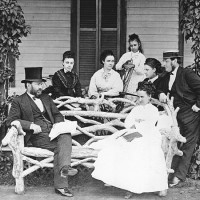
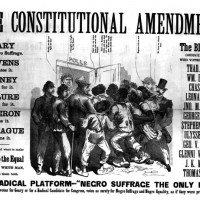
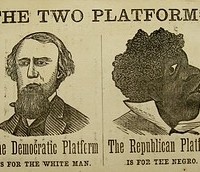
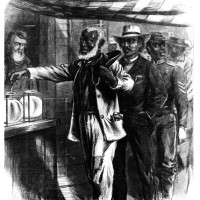


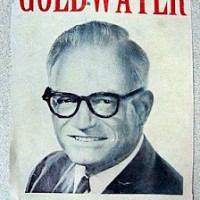

Thank you for this informative website. Can you give me any information on the origin of the poster above (The Two Platforms)? I’ve seen a variation of it for a PA governor race, but have also seen it traced to the presidential election of 1856.
This is part of a series of posters issued during the governor’s race in Pennsylvania in 1866. The series is in the Library of Congress. See https://www.loc.gov/pictures/item/2008661700/
I’m Black Republican living in an obscure Democratic 90% black town. Thank you for sharing this information love to learn more.
Actually that photo shows Nixon is flashing the “peace” sign that was popular with hippies. (Churchill’s Victory sign faces with the backside of the hand out.) 18-year-olds had just gotten the vote and Nixon wanted to woo them. Apparently the dumb kids fell for it and voted him in. (Except me. I didn’t fall for it.)
I know that a nit-picky thing, and it’s one of those things where you had to be there. It’s apparent you are taking great pains to make this historically accurate, so I thought I would make this minor correction.
Thanks for pointing that out, Jeanette!
For such a short article it was very informative. Though due to its brevity, the section discussing the “Southern Strategy” seemed to use cause and effect in a presumptuous way without providing supporting details. First, it gave the impression that the basis of States’ Rights was to support racial bias which I don’t believe was intended. Secondly, it – in effect – attributed the current Southern Republican vote to the successful campaign of the “Southern Strategy.” I hope that this wasn’t the intent of the literature, as this is a large generalization. Other than that I enjoyed the article.
Reply from scholar-griot Dr. Russell Brooker:
1. I did not mean to imply that the ONLY reason that people have supported states’ rights was to support racial bias. Many people have supported states’ rights for many reasons, racial and non-racial. I meant that people supporting racial bias used states’ rights as a reason to favor policies of racial bias. For example, states’ rights was invoked as a reason to oppose the Civil Rights Act of 1964.
2. I did mean to say that the current Republican support among Southern whites is a result of the successful campaign of the “Southern Strategy.” Nixon used the Southern Strategy to win in 1968 and 1972. Reagan used it to win in 1980. Since the 1988 election, the white Southern vote has been so overwhelmingly Republican that there has been no need to explicitly use the Southern Strategy. Would the white South have become so overwhelmingly Republican if Nixon and Reagan had never used the Southern Strategy? Almost certainly, it would have. Although there is no what to know for sure, it seems likely that blacks would have allied with the Democratic Party and the whites with the Republican Party even if nobody had thought of the Southern Strategy. Of course, it seems impossible to envision a scenario in which Nixon and Reagan would not have thought of the Southern Strategy.
bro just stop caring so much and read the article like a normal person
The way that The Conservative Republicans are doing things in blocking President O’bama .Is the same way that they did to Black Republicans in the 1800!
My understanding of Johnson passing the “Civil Rights Act” was due to pressure from Martin Luther King. The demonstrations against segregation were instrumental.
Mia Love was elected from Utah, not Nevada.